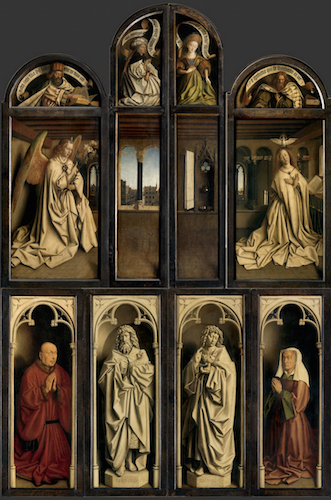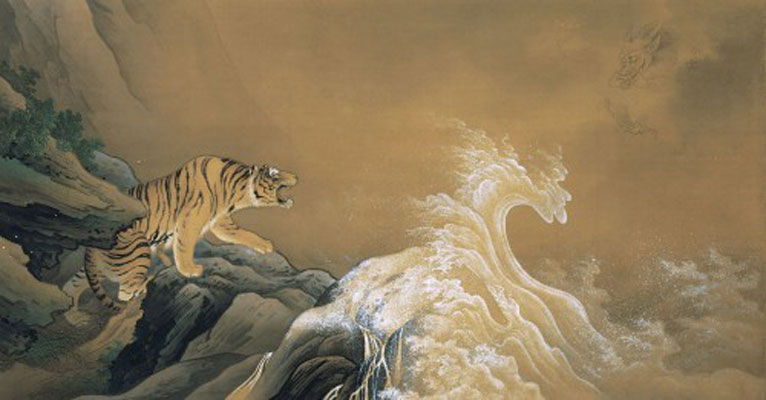Ghent Altarpiece open
History of the Altarpiece
Jan Van Eyck and his brother Hubert were commissioned to paint the polyptych Ghent Altarpiece by patrons Jodocus Vijd and his wife Elizabeth Borluut for the Church of Saint John (now known as the Cathedral of Saint Bavo) in Ghent, Belgium (Hickson). It is unknown when the two brothers began their work, but it is believed to have been before 1422 and completed in 1432. Another thing still unclear is how much each brother contributed, but it is widely believed that it was Jan who completed most of the panels.

Ghent Altarpiece closed, patrons Jodocus and Elizabeth are in the bottom corners of the piece
Exterior
The exterior of the piece, which is what was on display for most of the year, contains three layers. The bottom layer from left to right contains Jodocus, St. John the Baptist, St. John the Evangelist, and Elizabeth. The middle layer contains the Archangel Gabriel and Mary, it depicts Gabriel announcing to Mary she'll be the mother of Christ. The very top layer has the Prophet Zacharias, Erythraean Sibyl, Cumaean Sibyl, Prophet Micah.
The amount of detail the Van Eyck's were able to achieve is evident, especially in the middle layer with Gabriel and Mary. In the window between the two, you can see the skyline of Ghent

Details from the window between Gabriel and Mary
Interior
There is so much going on within the interior and it is a huge piece, I'll include a diagram of what each panel is representing and some close up of the details. Being that this is an altarpiece, the images and symbolism are very religious. The bottom layer is depicting people coming to the Holy Lamb, a symbol of Jesus Christ. In the close-up of the Holy Lamb, you can see that the lamb is bleeding and is said to represent the Eurachrist. Behind the altar with the lamb are angels carrying the cross, crown of thorns, and nails that Jesus Christ was to have been subjected to before his death.
There is a lot more symbolism present, but unfortunately to get into all of that would probably take a whole book and cannot fit into one blog post.

Interior view labeled

Zoomed in view of Adoration of the Holy Lamb

Close up of the Deity
Humanism
The humanism influence in Jan Van Eyck's work can be seen throughout this altarpiece. It is present in the amount of detail and beauty within the piece and each part of the piece represents something and has its own role. He is presenting divine figures as beautiful and as human, and linear perspective can be seen throughout which emerged during this time period. Each person, angel, and animal within the painting is done with care and purpose. You still get a sense that this is a religious work, but there is also a sense of reliability within it as well.
My Thoughts
This is one of my favorites done by Jan Van Eyck, its something you could stare at all day and still find something new within it. While I am not particularly religious, I can appreciate the symbolism and how stories from the bible are depicted. His mastery over oil paints is obvious when you get in close to the panels and spot all the small details hidden, and stepping back and seeing it all together you can see the story.
Work Cited
Hickson, Dr. Sally. “Jan Van Eyck, The Ghent Altarpiece.” Smarthistory, 9 Aug. 2015, smarthistory.org/van-eyck-the-ghent-altarpiece/.
“Jan Van Eyck Biography, Life & Quotes.” The Art Story, www.theartstory.org/artist/van-eyck-jan/life-and-legacy.
Pioch, Nicolas. “Eyck, Jan Van.” WebMuseum: Eyck, Jan Van, 19 Sept. 2002, www.ibiblio.org/wm/paint/auth/eyck/.


No comments:
Post a Comment